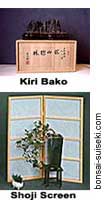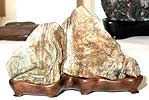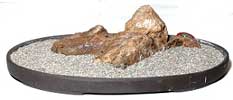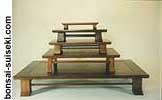One of the most important aspects of suiseki is the great care which is taken in displaying stones - using appropriate containers and display elements. Suiseki should always be the predominant element and the container or surroundings should never detract from the stone. The two most common traditional methods  of display arethe Daiza and the Suiban. of display arethe Daiza and the Suiban.
Common Japanese suiseki display items
daiza: a carved wood base conforming to the shape of the stone
dai: means stand, rack or rest; aka daiza
suiban: a shallow tray filled with sand and/or water
doban: metal suiban, usually bronze
shoku: small wood display tables
bako: box for protecting, storing and transporting suiseki
kiri bako: box for suiseki with daiza; light Paulownia wood used for lightness and protection from moisture
jiita: thin hardwood boards placed under suiseki
tokonoma: an alcove 3 feet deep, 6 to 9 feet wide; usually displays suiseki and other objects
shoji screens
Overall Design
When creating a beautiful display area, use great care and consideration.
one object clearly the main subject of display
placing main object on higher stand creates emphasis
main object is complimented by shape and theme of accompanying pieces
accompanying pieces should be lower in height
number of objects kept to minimum, usually three
[read more]
 The Daiza
The Daiza
The daiza (or dai) is a carved wood base conforming to the shape of the stone. The art of daiza carving is a specialized skill involving careful attention to the detail of the stone for which it is being created. Learn about the steps in creating these beautiful suiseki display items.
[read more]
 The Suiban and The Doban
The Suiban and The Doban
The suiban and doban are shallow, oval or rectangular trays used to display suiseki, filled with sand and/or water. Soft delicate smooth suiseki are best suited to more shallow and oval trays with a narrow lip or no lip and plain legs.
[read more]

The Tokonoma
Suiseki are often displayed in a tokonoma, a traditional Japanese method of display. The tokonoma usually contains one suiseki plus 1-2 other objects, chosen and combined with great care.
[read more]

Table Displays - The Shoku
The Japanese display table is called a shoku, often used in combination with other suiseki display items such as a daiza or suiban. The most attractive tables are made fine woods, often polished teak or rosewood, with simple curved or straight legs.
[read more]

Other Displays: Shelves, Stands, Corner Tables
Display areas can be created in any home regardless of style or cultural orientation, such as with today's western-style rooms and furniture. The suiseki should be more predominant than the table or shelf.
[read more]
|